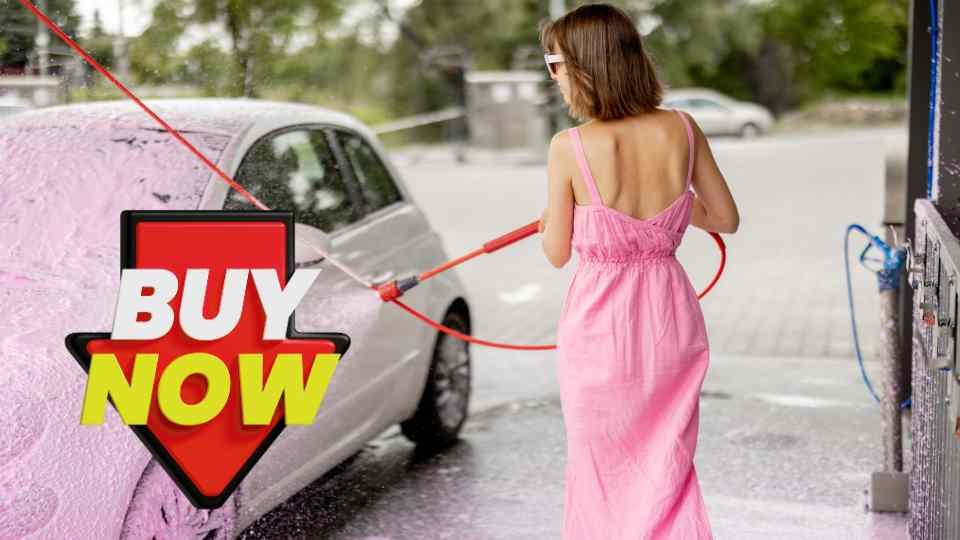Self Car Wash: Embarking on a journey to achieve the perfect self car wash is not just about cleaning your vehicle; it’s a therapeutic and rewarding experience that ensures your prized possession stays in top-notch condition. In this comprehensive guide, we’ll delve into every aspect of self car washing, providing you with step-by-step instructions, essential tips, and the tools you need to transform your car cleaning routine.
The Ultimate Guide to Achieving the Perfect Self Car Wash
Buy Car Wash Products HERE
I. Getting Started: The Right Mindset and Preparation
Before diving into the physical aspect of washing your car, it’s crucial to adopt the right mindset and prepare adequately for the task at hand.
1. Mindset Matters:
Embrace the process as an opportunity to bond with your vehicle. A self car wash isn’t just about removing dirt; it’s about investing time in preserving your car’s aesthetics and longevity.
2. Gather Your Arsenal:
List and explain the essential tools and supplies needed, from the right soap to brushes, buckets, microfiber cloths, and more. This section also covers the importance of choosing the correct cleaning products for different surfaces.
II. Choosing the Perfect Location
The location you choose for your self car wash can significantly impact the results. This section covers the ideal settings and precautions to take to ensure an efficient and safe car washing process.
1. Outdoor vs. Indoor Washing:
Discuss the pros and cons of washing your car outdoors versus indoors. Consider factors such as weather conditions, convenience, and the impact on water usage.
2. Water Conservation Tips:
Provide practical tips on how to minimize water usage during your self car wash, promoting eco-friendly practices and responsible water management.
III. The Art of Pre-Wash: Setting the Foundation
Before you touch your car with a sponge, a proper pre-wash routine is essential to remove loose dirt and contaminants. Explore the following aspects in detail:
1. Rinse and Soak:
Explain the importance of thoroughly rinsing your car before applying any cleaning products. This step helps to loosen dirt and prevent scratches during the wash.
2. The Two-Bucket Method:
Delve into the details of the two-bucket method, emphasizing its role in preventing swirls and scratches. Provide a step-by-step guide on how to use this technique effectively.
IV. The Main Event: Washing Your Car Like a Pro
Now that the foundation is set, it’s time to tackle the main washing process. Break down the steps involved and offer insights into the best practices for achieving a spotless finish.
1. Proper Technique:
Demonstrate the correct techniques for washing different parts of the car, from the body to the wheels and tires. Highlight the importance of using a gentle touch to avoid damaging the paint.
2. Drying Methods:
Discuss various drying methods, such as air drying, chamois, and microfiber towels. Address the potential risks associated with improper drying and how to mitigate them.
V. Beyond the Basics: Advanced Tips for Car Enthusiasts
For those looking to take their self car wash to the next level, explore advanced techniques and tips to achieve professional-grade results.
1. Clay Bar Treatment:
Introduce the concept of clay bar treatment for removing embedded contaminants and restoring smoothness to the paint surface. Provide step-by-step instructions for incorporating this technique into the car wash routine.
2. Waxing and Polishing:
Guide readers through the process of waxing and polishing to enhance their car’s shine and protection. Highlight the benefits of these steps and the recommended frequency for optimal results.
VI. Troubleshooting and Common Mistakes
Even seasoned car wash enthusiasts can encounter challenges. This section addresses common mistakes and provides solutions to ensure a seamless self car wash experience.
1. Avoiding Scratches and Swirl Marks:
Detail the common causes of scratches and swirl marks and offer preventive measures to keep your car’s paint in pristine condition.
2. Dealing with Stubborn Stains:
Provide tips and product recommendations for tackling stubborn stains that may not be resolved with a standard wash.
Conclusion: Revel in the Results of Your DIY Car Wash
Wrap up the guide by reinforcing the sense of accomplishment that comes with a well-executed self car wash. Remind readers of the importance of regular maintenance and how a personalized touch can make all the difference in preserving the beauty and value of their vehicles.
By following this comprehensive guide, car enthusiasts and novices alike can elevate their self car wash game, turning a routine task into a gratifying experience that pays dividends in the form of a gleaming, well-maintained automobile. Happy washing
Buy Car Wash Products HERE
Benefits of Self Car Wash
When it comes to keeping your vehicle in pristine condition, opting for a self car wash offers a multitude of benefits. Not only does it contribute to the overall aesthetic appeal of your car, but it also plays a crucial role in its long-term maintenance. Let’s explore the various advantages of choosing a self car wash over alternative options:
1. Personalized Care:
One of the most significant benefits of a self car wash is the personalized care you can provide to your vehicle. Unlike automated car washes, where one size fits all, a DIY approach allows you to tailor the cleaning process to the specific needs of your car. You can pay attention to trouble spots, delicate areas, and unique features that may require special attention.
2. Preservation of Paint and Finish:
Automated car washes, particularly those with stiff brushes or harsh chemicals, can cause micro-scratches and wear down the clear coat over time. With a self car wash, you have control over the tools and products used, minimizing the risk of damage to your car’s paint and finish. This hands-on approach helps preserve the overall appearance and resale value of your vehicle.
3. Cost-Effectiveness:
While automated car washes may seem convenient, the costs can add up over time. Self car washing allows you to invest in high-quality cleaning products and equipment upfront, often resulting in long-term cost savings. Additionally, you can choose eco-friendly options and control water usage, contributing to both financial and environmental sustainability.
4. Therapeutic and Bonding Experience:
For many car enthusiasts, washing their vehicle is not just a chore; it’s a therapeutic and enjoyable experience. Engaging in a self car wash can be a stress-relieving activity, providing a sense of accomplishment and satisfaction. It also offers an excellent opportunity for bonding with your car, fostering a deeper connection between you and your vehicle.
5. Attention to Detail:
A self car wash allows you to pay meticulous attention to every detail of your vehicle. From the crevices of the wheel rims to the intricate designs on the grille, you can ensure that no part is overlooked. This attention to detail not only enhances the cleanliness of your car but also contributes to a polished and well-maintained appearance.
6. Eco-Friendly Practices:
Automated car washes often use a significant amount of water, and the chemicals they use may not be environmentally friendly. With a self car wash, you have the option to implement water-saving techniques, such as the two-bucket method, and choose eco-friendly cleaning products. This environmentally conscious approach aligns with the growing trend of sustainable living.
7. Flexibility and Convenience:
A self car wash provides the flexibility to wash your car at a time that suits your schedule. Whether it’s early morning, late at night, or during the weekend, you have the convenience of choosing when to perform the cleaning. This flexibility is especially beneficial for those with busy lifestyles.
8. Knowledge and Skill Development:
Engaging in a self car wash allows you to develop valuable knowledge and skills related to car care. Over time, you’ll become more adept at identifying potential issues, choosing the right cleaning products, and executing effective cleaning techniques. This empowerment not only enhances your car maintenance abilities but also deepens your appreciation for your vehicle.
In conclusion, a self car wash is more than just a means to a clean car; it’s a holistic approach to vehicle maintenance that combines personalization, cost-effectiveness, and environmental consciousness. By investing time and effort into caring for your car, you not only reap immediate rewards in terms of appearance but also contribute to the longevity and overall well-being of your cherished vehicle
Buy Car Wash Products HERE
Things to Ensure While Washing Your Car Yourself For Perfect Wash
Achieving the perfect car wash requires attention to detail and a systematic approach. Here’s a comprehensive list of things to ensure while washing your car yourself to ensure a flawless and effective result:
1. Gather Your Supplies:
Before starting the car wash, ensure that you have all the necessary supplies, including:
- Quality car wash soap
- Two buckets (one for soapy water and one for rinsing)
- Soft wash mitts or microfiber sponges
- Soft-bristle brushes for wheels and tires
- Wheel cleaner
- Microfiber towels or chamois for drying
- Glass cleaner
- Tire dressing (optional)
- Clay bar (for advanced cleaning, if needed)
2. Choose the Right Location:
Select a suitable location for the car wash, preferably in a shaded area to avoid water spots and sun-drying the soap. If you’re washing indoors, ensure proper drainage and ventilation.
3. Pre-Wash Inspection:
Conduct a thorough inspection of your car before starting the wash. Identify any areas with heavy dirt, tar, or bird droppings, as these may require special attention or additional cleaning steps.
4. Use the Two-Bucket Method:
Implement the two-bucket method to prevent contaminants from being transferred back onto the car’s surface. One bucket is for soapy water, and the other is for rinsing your wash mitt or sponge.
5. Pre-Rinse Your Car:
Before applying soap, give your car a thorough pre-rinse to remove loose dirt and debris. Use a hose or pressure washer for this step.
6. Follow a Top-Down Washing Order:
Start washing from the top of the car and work your way down. This prevents dirty water from the upper areas of the car from contaminating the lower, cleaner parts.
7. Use Proper Washing Techniques:
When washing, use gentle, straight-line motions rather than circular ones to minimize the risk of swirl marks. Pay extra attention to areas prone to dirt accumulation, such as the lower panels and behind the wheels.
8. Clean Wheels and Tires Separately:
Use a dedicated set of brushes and cleaning products for wheels and tires. Avoid using the same tools for your car’s body to prevent cross-contamination.
9. Rinse Thoroughly:
After washing each section, rinse thoroughly to remove all soap residue. Ensure that no soap is left on the car’s surface, especially in crevices and seams.
10. Dry with Care:
Use a soft microfiber towel or chamois to dry your car. Pat the surface rather than rubbing to avoid introducing micro-scratches. Dry in sections to prevent water spots.
11. Pay Attention to Glass:
Clean your windows and mirrors last, using a dedicated glass cleaner. Wipe in a back-and-forth motion on the exterior and a side-to-side motion on the interior for better visibility.
12. Consider Advanced Cleaning Techniques:
If your car’s paint feels rough to the touch, consider using a clay bar to remove embedded contaminants. Follow the clay bar treatment with waxing and polishing for an extra layer of protection and shine.
13. Address Stubborn Stains:
For persistent stains or tar, use specialized cleaners or spot treatments. Avoid using abrasive materials that could damage the paint.
14. Inspect for Missed Spots:
After the car is dry, inspect it for any missed spots or areas that require additional attention. Touch up as needed.
15. Finish with Tire Dressing (Optional):
If you like, apply a quality tire dressing to enhance the appearance of your tires. Ensure it doesn’t sling onto the car’s body.
16. Maintain Regularly:
Keep your car in top condition by establishing a regular washing schedule. Regular maintenance reduces the need for intensive cleaning sessions.
By following these meticulous steps and paying attention to the details, you can ensure that your self car wash results in a perfectly clean and well-maintained vehicle. Each step contributes to not only the cleanliness but also the longevity and overall aesthetics of your car
Buy Car Wash Products HERE
Register for My Upcoming Masterclass HERE
See You in the Live Masterclass
Sunil Chaudhary stands as a preeminent global Leading digital coach, boasting a diverse clientele hailing from over 50 nations. Renowned for his prowess as an exemplary SEO expert, business automation coach, and landing page authority, Chaudhary also holds the distinction of being esteemed as the finest business coach in India. Beyond technical domains, he imparts invaluable insights into mindset, success, and life skills, thus encompassing a holistic approach to mentorship.
Join FREE Courses HERE
Know The Author:
 Sunil Chaudhary aka Suniltams Guruji is India’s Leading Digital Coach. He provides complete Digital Skill Development Coaching with great support. Sunil has trained more than 25000 students and helped more than 1100 businesses so far. Sunil is a well-known face across the world for Digital Coaching.
Sunil Chaudhary aka Suniltams Guruji is India’s Leading Digital Coach. He provides complete Digital Skill Development Coaching with great support. Sunil has trained more than 25000 students and helped more than 1100 businesses so far. Sunil is a well-known face across the world for Digital Coaching.
Digital Success Coach | Best SEO Coach India | Mindset Coach | Life Success Coach
Top 50 FAQs Related to Self Car Wash with Answers
1. Q: Why should I choose a self car wash over an automated car wash? A: Self car wash allows for personalized care, attention to detail, and the use of high-quality products, contributing to better maintenance and preservation of your vehicle.
2. Q: What’s the ideal frequency for washing my car? A: Washing your car every two weeks is a good rule of thumb, but adjust based on environmental factors, such as weather conditions and exposure to contaminants.
3. Q: Can I use dish soap for washing my car? A: It’s not recommended. Dish soap can strip away wax and protective coatings, potentially harming your car’s finish. Use a dedicated car wash soap.
4. Q: What’s the two-bucket method, and why is it important? A: The two-bucket method involves using one bucket for soapy water and another for rinsing your wash mitt. It prevents dirt from being transferred back to the car’s surface.
5. Q: Is it better to wash my car in the shade or sun? A: It’s preferable to wash your car in the shade to prevent water spots and soap residue from drying too quickly.
6. Q: How can I conserve water during a self car wash? A: Use a nozzle on your hose, implement the two-bucket method, and consider waterless wash products to minimize water usage.
7. Q: Can I use the same sponge for my car’s body and wheels? A: It’s not recommended. Wheels can harbor abrasive particles that may scratch the car’s paint. Use separate tools for wheels and the body.
8. Q: Should I wash my car’s engine? A: It’s generally not necessary and can be risky. If you choose to clean the engine, use a degreaser and cover sensitive components.
9. Q: How do I clean stubborn bird droppings or tree sap? A: Use a specialized cleaner or a mixture of water and vinegar. Let it soak, then gently wipe or rinse off.
10. Q: Can I wash my convertible with a soft top? A: Yes, but use a cleaner specifically designed for convertible tops. Avoid harsh brushes that may damage the material.
11. Q: What’s the proper way to dry my car? A: Use a soft microfiber towel or chamois and pat the surface dry to avoid scratches. Dry in sections to prevent water spots.
12. Q: How do I clean water spots from my car’s paint? A: Use a mixture of vinegar and water or a dedicated water spot remover. Apply with a soft cloth and buff gently.
13. Q: Can I wash my car with regular tap water? A: Yes, but hard water may leave mineral deposits. Consider using filtered or softened water for a spot-free finish.
14. Q: Is it okay to wash my car in cold weather? A: Yes, but make sure to use a car wash soap formulated for cold temperatures, and dry the car thoroughly to prevent freezing.
15. Q: How do I clean the interior during a self car wash? A: Focus on vacuuming, wiping surfaces with a suitable cleaner, and using glass cleaner for windows.
16. Q: Can I use a pressure washer to wash my car? A: Yes, but use a wide-angle nozzle and keep a safe distance to avoid damaging the paint or forcing water into sensitive areas.
17. Q: What’s the best way to clean alloy wheels? A: Use a dedicated wheel cleaner and a soft brush. Avoid acidic cleaners that may damage the finish.
18. Q: How often should I wax my car? A: Waxing every 3-6 months provides a protective layer against contaminants and enhances the car’s shine.
19. Q: Can I use a leaf blower to dry my car? A: Yes, a leaf blower can be effective for drying, but use a gentle setting to avoid scratching the paint.
20. Q: How do I prevent swirl marks? A: Use proper washing techniques, like the two-bucket method, and avoid circular motions when washing.
21. Q: What’s the purpose of a clay bar treatment? A: A clay bar removes embedded contaminants from the paint, leaving it smooth and ready for waxing.
22. Q: Can I wash my car with just water? A: While water alone can remove some dirt, using a dedicated car wash soap is recommended for optimal cleaning without damaging the paint.
23. Q: Is it okay to wash my car after it rains? A: Yes, but be cautious of potential contaminants from rainwater. A post-rain wash can help maintain your car’s cleanliness.
24. Q: Can I use a dishwasher sponge for washing my car? A: No, dishwasher sponges may have abrasive materials. Stick to soft wash mitts or microfiber sponges designed for cars.
25. Q: How can I clean water stains from my car’s glass? A: Use a glass cleaner with a mixture of water and vinegar. Apply with a microfiber cloth and buff until clear.
26. Q: Is it necessary to dry my car if I use a waterless wash product? A: Yes, drying is still recommended to ensure a streak-free finish and prevent water spots.
27. Q: Can I use a household sponge for cleaning my car? A: It’s not recommended, as household sponges may contain abrasive materials that can scratch the paint. Use automotive-grade wash mitts or sponges.
28. Q: How do I clean bugs off my car’s front bumper? A: Use a bug and tar remover or a mixture of water and dish soap. Allow it to soak before gently wiping or rinsing.
29. Q: Can I use a pressure washer on convertible tops? A: Use a gentle setting and keep a safe distance to avoid damaging the fabric. Follow up with a convertible top cleaner and protectant.
30. Q: What’s the best way to clean the windshield wipers? A: Wipe them with a damp cloth and a bit of rubbing alcohol to remove dirt and grime.
31. Q: Can I use a hairdryer to dry my car? A: While it may work for small areas, it’s not practical for the entire car. Stick to a microfiber towel or chamois for thorough drying.
32. Q: How do I clean the interior fabric upholstery? A: Vacuum first, then use a fabric cleaner or a mixture of water and mild detergent. Blot, don’t rub, to avoid spreading stains.
33. Q: Is it necessary to clean the undercarriage of my car? A: Periodically cleaning the undercarriage helps remove salt, dirt, and debris, reducing the risk of corrosion.
34. Q: Can I wash my car with hot water? A: Yes, warm water can help loosen dirt and make cleaning more effective, especially in colder weather.
35. Q: How can I prevent water spots on my windows? A: Dry the windows promptly after washing and consider using a glass sealant to repel water.
36. Q: What’s the best way to clean a car’s sunroof? A: Use a mild cleaner and a soft cloth or sponge. Be gentle around the edges to avoid damaging the seals.
37. Q: Can I wash my car during winter? A: Yes, but choose a milder day, use warm water, and dry thoroughly to prevent freezing.
38. Q: How do I clean a car with matte paint? A: Use a pH-neutral car wash soap and avoid waxing. Matte paint requires special care to maintain its finish.
39. Q: Can I use a leaf blower to dry the engine bay? A: It’s not recommended, as a leaf blower may force water into sensitive components. Allow the engine to air dry or use a gentle stream of compressed air.
40. Q: Is it okay to wash my car’s windows in direct sunlight? A: It’s best to avoid direct sunlight, as it can cause cleaning products to dry too quickly, leaving streaks. Choose a shaded area if possible.
41. Q: How do I clean the interior dashboard and trim? A: Use a dedicated interior cleaner and a soft microfiber cloth to avoid scratches. Consider using a protectant for added shine and UV protection.
42. Q: Can I wash my car with a power washer? A: Yes, but use a wide-angle nozzle and maintain a safe distance to prevent damage to the paint or trim.
43. Q: How do I clean salt stains from my car’s carpet? A: Vacuum first, then use a mixture of water and vinegar or a carpet cleaner. Blot the area to remove stains.
44. Q: Can I wash my car with laundry detergent? A: Laundry detergent is not recommended, as it may contain harsh chemicals that can damage your car’s paint. Stick to dedicated car wash soaps.
45. Q: How do I clean the air vents in my car? A: Use a small brush or compressed air to remove dust. Consider a specialized vent cleaner for a thorough clean.
46. Q: Can I wash my car’s headlights with toothpaste? A: Toothpaste can be abrasive and may scratch the headlight lenses. Use a dedicated headlight cleaner for optimal results.
47. Q: What’s the best way to clean a car’s exhaust tips? A: Use a metal cleaner or a mixture of water and baking soda. Scrub gently with a soft brush to remove built-up residue.
48. Q: How do I clean leather seats in my car? A: Vacuum first, then use a leather cleaner and conditioner. Follow the product instructions for best results.
49. Q: Can I wash my car during a drought? A: Consider using a waterless wash product or visit a commercial car wash that recycles water. Minimize water usage if washing at home.
50. Q: How do I clean a convertible top with mold or mildew? A: Use a dedicated convertible top cleaner and a soft brush. Allow the cleaner to sit, then rinse thoroughly. Consider applying a fabric protectant
















